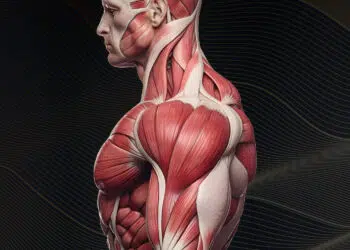The rear deltoids are a lagging muscle group for most people. Located on the back of your shoulders, the rear delts are often out of sight, so they’re out of mind. Very few lifters single out their rear delts for direct training.
Weak rear deltoids can hurt your shoulder health, posture, and aesthetics. Although this muscle might be small, it’s still important! As a personal trainer with over 35 years in the business, I have helped numerous people transform their posterior deltoids with nothing more than cable exercises.
I prefer cable exercises for training the posterior deltoids as they maintain constant tension on the target muscles throughout the range of motion (ROM), maximizing muscle stimulation and hypertrophy. In this article, I reveal the eight best cable exercises for targeting your rear delts.
Recent Updates: On June 7, 2024, Fitness Volt’s Senior Editor, Vidur Saini (American Council on Exercise-CPT), updated the article and added actionable expert tips throughout the piece to improve the reader experience.
Level Up Your Fitness: Join our 💪 strong community in Fitness Volt Newsletter. Get daily inspiration, expert-backed workouts, nutrition tips, the latest in strength sports, and the support you need to reach your goals. Subscribe for free!
8 Best Cable Rear Delt Exercises
Want to beef up your rear delts with cables? These are the best exercises for your goal!
- Cable face pull
- Seated wide grip cable row
- Reverse cable crossover
- Cable external rotation
- Single-arm cable rear delt fly
- Cable supine reverse fly
- Cable overhead press
- Cable Cuban press
1. Cable face pull
| Sets & Reps | 3 x 10-15 |
| Equipment Needed | High-pulley cable machine, rope attachment |
| Target Muscles | Posterior deltoids, rhomboids, middle trapezius |
The cable face pull is one of the best rear delt exercises you can do. Not only does it target your posterior deltoids, but it also works your middle trapezius and rhomboids. These muscles often work together and are crucial for shoulder stability and posture.
So, do yourself a favor and do a few sets of cable face pulls 2-3 times a week. Your shoulders will thank you!
“Pull your elbows apart and back rather than just pulling the rope towards your face,” said Saini. “This will engage the rear deltoids and rhomboids more effectively and promote better scapular retraction.”
How to do it:
- Attach a rope handle to a cable pulley set to around face level.
- Stand with your feet hip-width apart so that you’re in an upright posture.
- Grab both sides of the handle with a neutral grip. Place one foot in front of the other for balance.
- Lower your elbows slightly but keep hands at head level.
- Pull the rope toward your face as far as possible while pulling both handles apart.
- Extend your arms and repeat for the desired number of reps.
Pro tip: Avoid using your lower back during this exercise by sitting backward on an exercise bench with the backrest set to vertical. Rest your chest against the backrest and keep it there for the duration of your set, like this:
| Difficulty | Beginner |
| Progression | Add a pause at the peak contraction |
| Regression | Perform seated face pulls with a resistance band |
2. Seated wide grip cable row
| Sets & Reps | 3 x 8-12 |
| Equipment Needed | Low-pulley cable machine, wide grip bar attachment |
| Target Muscles | Latissimus dorsi, rhomboids, middle trapezius, biceps brachii |
Regular seated rows are an excellent lat exercise that also works your posterior deltoids. However, using a wider grip and pulling the bar into your chest instead of your abs better biases the posterior delts.
You won’t be able to lift as much weight as usual, as this is not a very biomechanically efficient movement. However, you’ll really feel it in your rear delts.
Saini recommends initiating the movement by retracting your shoulder blades (imagine squeezing a pencil between them) before pulling with your arms.
How to do it:
- Attach a long bar to your seated row machine. Hold the handle with an overhand, wider-than-shoulder-width grip. Sit up straight with your knees slightly bent and core braced. Pull your shoulders down and back.
- Leading with your elbows and keeping your wrists straight, bend your arms and pull the bar into your chest.
- Extend your arms and repeat.
Pro tip: Try doing a set of wide-grip seated rows to the chest immediately followed by a set of regular seated rows to really pump up your rear deltoids and build your lats.
| Difficulty | Intermediate |
| Progression | Slower eccentric (lowering) phase |
| Regression | Perform single-arm cable rows |
3. Reverse cable crossover
| Sets & Reps | 3 x 10-15 |
| Equipment Needed | Cable machine |
| Target Muscles | Posterior deltoids, rhomboids, middle trapezius |
The cable crossover machine can train virtually every muscle group, including the rear delts. Reverse cable flyes, as they are popularly known, allow you to isolate your rear delts with laser-like accuracy. However, you’ll need to go light as this exercise is far more challenging than it looks because of the long levers involved.
Saini suggests keeping the elbows slightly higher than the wrists throughout the exercise to load the rear delts and limit lat engagement.
How to do it:
- Stand in the middle of a cable crossover machine with the pulleys pinned at the highest setting.
- Hold the left cable in your right hand and vice-versa.
- Cross your wrists in front of you with your arms extended but elbows slightly bent.
- Brace your core and pull your shoulders down and back.
- Open your arms and pull your elbows back until they are slightly behind your shoulders.
- Squeeze your shoulders together to maximize rear delt muscle engagement.
- Return to the starting position and repeat.
Pro-tip: Experiment with the height of your arms to hit your deltoids from different angles. Try moving from low to high and not just high to low.
| Difficulty | Beginner |
| Progression | Increase weight, perform standing, add a pause at the peak contraction |
| Regression | Decrease weight, perform with resistance bands |
4. Cable external rotation
| Sets & Reps | 3 x 12-15 |
| Equipment Needed | Low-pulley cable machine, D-handle |
| Target Muscles | Infraspinatus, teres minor (rotator cuff muscles), rear delts |
External rotation is one of the most underused functions of the posterior deltoids. This exercise is often thought of as a rotator cuff exercise, which it is, but you’ll also feel it deep in your rear delts.
Don’t go too heavy with this exercise; it’s a subtle, controlled movement that works best with light weights and medium to high reps.
“You must focus on the rear delts on the eccentric phase and prioritize a deep stretch for optimal muscle stimulation,” says Saini. “Pivot your body away from the pulley for optimal activation in the bottom position.”
How to do it:
- Set an adjustable cable machine to around waist height. Attach a D-shaped handle to the pulley.
- Stand side-on to the weight stack and hold the handle in your furthest hand.
- Bend your elbow to 90 degrees, tuck your upper arm into your side, and position your forearm across your upper abdomen.
- Without twisting your hips or shoulders, rotate your arm outward as far as you comfortably can.
- Return to the starting position and repeat.
Pro tip: Place a folded towel under your arm and hold it there throughout the exercise to remind you to keep your elbow close to your ribs for maximal muscle engagement.
| Difficulty | Beginner |
| Progression | Slow down the tempo |
| Regression | Perform with a resistance band |
5. Single-arm cable rear delt fly
| Sets & Reps | 3 x 10-12 per arm |
| Equipment Needed | Cable machine |
| Target Muscles | Posterior deltoids |
The advantage of this exercise over other rear deltoid moves is that it allows you to train one arm at a time. This deepens the mind-muscle connection and can help identify and fix strength and muscle imbalances. As an added benefit, you just need a single cable to do this exercise, so it’s ideal for busy or less well-equipped gyms.
Saini adds that the bent-over position allows you to isolate the rear delts and ensure they are doing most of the work.
How to do it:
- Stand side-on to a low pulley machine and hold the cable with your furthest hand.
- Bend your knees slightly, hinge forward from your hips so your torso is parallel to the floor.
- Brace your abs and pull your shoulders down and back.
- Draw your arm across and up until it aligns with your shoulders.
- Return to the starting position and repeat.
Pro tip: You can also do this exercise using both arms simultaneously, which can be a useful time-saving option for some lifters. However, you will lose the unilateral benefits of training each arm independently.
| Difficulty | Beginner |
| Progression | Pec deck rear delt flye |
| Regression | Use a resistance band |
6. Cable supine reverse fly
| Sets & Reps | 3 x 12-15 |
| Equipment Needed | Cable machine |
| Target Muscles | Posterior deltoids, rhomboids, middle trapezius |
The cable supine reverse fly is an effective posterior deltoid isolation exercise. When done face-up on a flat bench, it supports your lower back and eliminates the possibility of using momentum.
Exhale sharply as you pull the cables and squeeze your shoulder blades together at the movement’s top, says Saini.
How to do it:
- Begin by setting up the pulley handles at the highest point on each side.
- Grab the left pulley with alternate hands so the cables cross each other.
- Lie down on the bench with your shoulders level with the pulleys.
- Pull your arms out and down until your hands are level with your shoulders.
- Return to the top of the movement, and then repeat for the desired number of reps.
Pro tip: Like many rear delt exercises, the one works best when performed with light to medium weights and moderate to high reps. Going too heavy will take the stress off the target muscles and put it on your arms and upper back.
| Difficulty | Beginner |
| Progression | Add a pause at the peak contraction |
| Regression | Pec deck flye |
7. Cable overhead press
| Sets & Reps | 3 x 6-8 |
| Equipment Needed | High-pulley cable machine, straight bar attachment |
| Target Muscles | Anterior deltoids, lateral deltoids, triceps brachii |
Most overhead pressing variations emphasize your anterior and medial deltoids. This exercise puts more tension on your rear delts as you’ll need to work extra hard to stop your arms from being pulled forward and down.
Saini recommends pressing slightly forward and up instead of pressing straight up. It also engages the serratus anterior muscle, which helps stabilize the scapula and can lead to better shoulder health and strength.
How to do it:
- Attach a straight bar to a pulley set at the lowest setting.
- Grip the handle with an overhand, slightly wider than shoulder-width grip.
- Curl or clean the handle up to your shoulders while facing the weight stack.
- Brace your core, pull your shoulders down and back, and stand with your feet roughly shoulder-width apart.
- Press the handle up and overhead.
- Lower the bar back to your shoulders and repeat.
Pro tip: Think about pressing the bar up and back in an arc to maximize rear deltoid engagement. This will also figure up your middle and lower traps and rhomboids.
| Difficulty | Intermediate |
| Progression | Use a split stance for added challenge |
| Regression | Perform seated, use dumbbells |
8. Cable Cuban press
| Sets & Reps | 3 x 8-12 |
| Equipment Needed | Cable machine, D-handles, or straight bar |
| Target Muscles | Anterior deltoids, lateral deltoids, trapezius, biceps brachii |
The Cuban press is a total shoulder exercise. It was once the secret weapon of the Cuban Olympic weightlifting team. This exercise works all three deltoid heads, ensuring overall development.
Slow down the switch at shoulder level to maximize rear delt engagement, recommends Saini.
Level Up Your Fitness: Join our 💪 strong community in Fitness Volt Newsletter. Get daily inspiration, expert-backed workouts, nutrition tips, the latest in strength sports, and the support you need to reach your goals. Subscribe for free!
How to do it:
- Attach a straight, revolving bar to a low pulley. Alternatively, if using a dual low-cable machine, you can use two D-shaped handles.
- Hold the bar/handles in front of your thighs with an overhand, slightly wider than shoulder-width grip. Brace your core.
- Bend your arms and upright row the bar up to your sternum.
- Next, rotate your arms out and away, raising the bar to your forehead.
- Finally, press the handle up and overhead to arms’ length.
- Return to the starting position by reversing this motion.
Pro tip: You can also do this exercise with dumbbells or a barbell, so you really have no excuse not to include it in your workouts!
| Difficulty | Intermediate |
| Progression | Slow down the tempo, add a pause at the peak contraction |
| Regression | Perform separate lateral raises and upright rows |
Best Cable Rear Delt Workout
The rear delts are a relatively small muscle group; you don’t need to dedicate an entire workout to training them. Below is a rear-delt-focused shoulder workout you can try the next time you hit the gym. Feel free to switch the posterior deltoid exercises to add variety to your workouts.
| Exercise | Sets | Reps | Rest (s) |
| Dumbbell Shoulder Press | 3 | 12 | 60 |
| Dumbbell Lateral Raise | 3 | 8 | 75 |
| Cable Y Raise | 3 | 10 | 60 |
| Cable Face Pull | 3 | 6 | 90 |
| Single-Arm Cable Rear Delt Fly | 3 | 10 | 75 |
Why Use Cables, Anyway?
Cables are arguably the best way to work your rear deltoids. Using cables means you can keep the target muscles under almost constant tension and really hammer home that all-important mind-muscle connection.
You can also use a cable machine to hit your rear delts from numerous angles. A small change in joint angle can have a significant impact on the effect of whatever exercise you are performing.
Finally, most cable machines have incremental weight stacks that start with a low load. The rear deltoid is not especially strong, so you don’t need a lot of weight to fatigue it. That’s especially true if you’ve been neglecting your rear delts recently.
Yes, you can use dumbbells and barbells to train your rear delts, but in nine cases out of 10, a cable machine will produce better results.
Deltoid Anatomy
Your shoulders are made up of three major muscles:
Anterior deltoid
Located at the front of your shoulder, the anterior deltoid is responsible for flexion, horizontal flexion, and medial rotation of the shoulder joint. As such, the front deltoid is involved in all chest and overhead pressing exercises. The anterior deltoid is generally the largest and most well-developed of the three.
Medial deltoid
Also known as the lateral deltoid, this muscle is located on the side of your shoulder. Its primary role is the abduction of the shoulder joint. Bodybuilders do exercises like dumbbell and cable lateral raises to target this muscle. The medial deltoid is responsible for the width of your shoulders and your V-taper.
Posterior deltoid
Positioned on the back of your shoulder, the posterior deltoid is responsible for extension, horizontal extension, and external rotation of the shoulder joint. While it is involved in most back exercises, bodybuilders typically do more pushing than pulling, which is why the posterior deltoid is often underdeveloped compared to the anterior deltoid.
Underdeveloped posterior deltoids can lead to poor posture, less upper body mass, and an unbalanced physique. It could also increase your risk of shoulder pain and injury. Weak posterior deltoids can impede your performance of several vital exercises, not least lat pull-downs, pull-ups/chin-ups, all types of row, and biceps curls.
That’s because the posterior deltoids act as stabilizers during these movements. If they fail before the muscle you’re targeting, your set will come to a premature halt, and your workout won’t be as productive.
So, if you want bigger biceps or lats, you must also strengthen your posterior deltoids!
FAQs
1. What’s the best way to program rear delt training if you’ve been neglecting them for a long time?
If you’ve not been doing much rear delt training, your anterior deltoids are probably strong and overdeveloped in comparison. If that’s the case, you need to deemphasize the bigger deltoid and do more volume for the smaller head.
One way to do this is with the 3-2-1 method.
Simply do three sets for your posterior deltoids, two sets for your medial deltoids, and only one set for your anterior deltoids. This will rebalance your shoulders in double-quick time.
For example:
- 3 sets of 12-15 face pulls (Posterior delts)
- 2 sets of 10-12 cable lateral raises (medial delts)
- 1 set of 6-8 barbell overhead presses (anterior delts)
Do this 1-2 times a week to develop strong, balanced, functional shoulders.
2. What’s the best rep range for training the rear delts?
Most rear delt exercises work best with light to moderate weight and medium to high reps. 12-20 is a good range for most people. Using heavier loads invariably leads to increasing upper back engagement, which may take tension off the muscles you want to train.
3. What’s the best rear delt exercise if you can’t go to the gym?
I’m a massive fan of two rear delt exercises that are perfect for home use — band pull-aparts and hand-release push-ups.
To do band pull-aparts:
- Seated or standing, hold a resistance band with an overhand, shoulder-width grip. Raise your arms out in front of you. Bend your arms slightly and pull your shoulders down and back.
- Open your arms and stretch the band out across your chest.
- Return to the starting position and repeat.
To do hand-release push-ups:
- Kneel down and place your hands flat on the floor, slightly wider than shoulder-width apart.
- Your fingers should be pointing directly forward.
- Walk your feet back, ensuring your body is straight and rigid; brace your core. Look straight down at the floor.
- Bend your arms and, under control, lower your chest to the floor. Keep your body tense and straight.
- Pull your shoulders down and back and lift your hands a few inches off the floor. Do not arch your lower back.
- Place your hands back on the floor and push yourself back up to return to the starting position.
- That’s one rep – keep going!
4. How often should I train my rear delts?
Assuming your rear delts are underdeveloped, I’d recommend training them at least twice a week and even every other day. For example, you can add extra rear delt exercises to your regular shoulder workout or do an exercise or two after any upper body session to stimulate rear delt growth.
Ultimately, training the rear delts just once a week probably won’t do much for their size or strength. Try to accumulate at least ten hard sets of rear delt training week to bring them up sooner.
5. How can I improve my posture faster?
Training your rear delts and upper back is a good start to fixing your posture, but you also need to stretch the muscles on the front of your chest and shoulders. Otherwise, these tight areas will always pull you forward into a slouch.
One way to do this is to superset chest stretches with rear deltoid exercises. This will increase your range of motion during the rear delt moves, and also make better use of your training time.
Check out this guide to stretching your pecs and anterior delts.
More Anterior Deltoid Exercises:
- I’m a Personal Trainer: The 3 Muscle Groups Most People NEVER Train (And Why It Shows)
- The 7 Best Trainer-Approved Exercises for Sculpted Shoulders
- 15 Best Shoulder Exercises According to a Fitness Expert
- Unlock Strength with Kettlebell Arnold Press for Upper Body
- Anterior Deltoid Exercises List
- Cuban Press: Master Your Shoulders and Enhance Stability
- Arnold Press: Target Deltoids, Traps, Triceps & Serratus
- 13 Ways to Avoid Shoulder Pain in The Gym
Wrapping Up
Are you guilty of neglecting your rear deltoids? Don’t worry — you are not alone. A lot of lifters forget all about their posterior deltoids because they can’t see them. It’s always more motivating to train the muscles you can see in the mirror, right?
The good news is that the rear delts are very responsive, and it won’t take much work to bring them up to par with your other shoulder muscles. After all, they’re pretty small and don’t need heavy weights. You should have no problem doing 2-3 sets of 1-2 exercises for them a couple of times a week without increasing fatigue or needing a lot more recovery.
You can even train your rear delts at home, as many of the exercises in this article can also be performed using resistance bands.
So, stop ignoring your rear delts and, instead, start working them hard and often. They’ll soon begin to grow and add a lot to your shoulder appearance, performance, posture, and joint health.
Interested in measuring your progress? Check out our strength standards for Push Ups, Face Pull, Cable Fly, and more.









